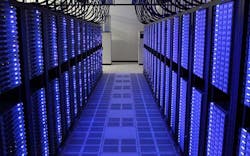With LinkedIn Deal, Microsoft Expands Wholesale Data Center Presence
With its $26 billion deal to acquire LinkedIn, Microsoft stands to become an even larger player in the market for wholesale data center space. LinkedIn has rapidly expanded its Internet infrastructure in recent years, leasing more than 30 megawatts of capacity from wholesale data center service providers.
LinkedIn has more than 430 million users, and has been scaling its IT infrastructure to keep pace with its rapid growth. After launching in 2008 with 20 servers, LinkedIn housed its servers in retail colocation facilities. In 2013 it began shifting to a wholesale strategy, teaming with Digital Realty on a new data center in Ashburn, Virginia.
“Our data center strategy is to partner with colocation providers to build wholesale data centers,” LinkedIn’s Michael Yamaguchi wrote in a recent blog post. In the wholesale model, customers lease entire data halls rather than renting capacity by the cage or cabinet, as seen in “retail” colocation.
The company has continued to add wholesale capacity and refine its operations to be more energy efficient and resilient. LinkedIn is in the process of deploying a new data center design that embraces liquid-cooled rear doors to support extreme power density across its data hall.
Big and Getting Bigger
Microsoft is already one of the largest players in the market for wholesale data center space. Microsoft has a long history of both building and buying infrastructure to support the rapid growth of its cloud business, but recently indicated that it has focused on traditional data halls.
The cloud giant has signed massive leases for data center space in three key markets this year, reserving 47 megawatts of space in northern Virginia, Silicon Valley and San Antonio, which will enable Microsoft to quickly ramp up its cloud operations to meet demand. Microsoft’s wholesale megadeals reportedly include two leases with CyrusOne – including a massive 22 megawatt deal for space in Sterling, Va. and a 9-megawatt lease in a San Antonio – as well as a 16 megawatt lease with DuPont Fabros Technology in Santa Clara, Ca.
The expansion is consistent with Microsoft’s public discussion of its cloud ambitions, and will help the company keep pace with its chief rivals in the fast-growing public cloud, which provides instant capacity for companies to run applications in other companies’ data centers.
For many years Microsoft expanded its footprint using modular data centers that it designed and built. Earlier this year the company said its expansion has accelerated to the point that it can’t keep up with demand using modular designs. That’s a major reason why it is currently focused on third-party wholesale space, which can often be deployed more rapidly than company-built data centers.
A Microsoft data center module at the company’s cloud campus in Quincy, Washington, packed with thousands of servers. (Photo: Microsoft)
LinkedIn’s Wholesale Footprint
LinkedIn has become a significant new player in the wholesale data center market. It has four leases with Digital Realty for 279,997 square feet of data center space, including capacity in three major markets:
- A facility in Ashburn, the premier data hub in Northern Virginia, with 9.6 megawatts of IT capacity
- Another 7.2 megawatts of capacity in Richardson, Texas in the Dallas market.
- A new data center in Singapore to serve the Asia-Pacific market, which currently houses 4.2 megawatts of load in about 23,000 square feet of space.
This year it is also adding wholesale space in an INFOMART data center near Portland, Oregon. LinkedIn is in the process of deploying the first 4 megawatts of capacity in Portland, with an additional 4 megawatts planned.
Although Microsoft would add at least 30 megawatts of wholesale space with the LinkedIn acquisition, the deal doesn’t appear to create any tenant concentration challenges for publicly-held data center real estate investment trusts (REITs). Analysts sometimes see portfolio risk when a REIT’s revenue becomes dependent on a single tenant. Because the two companies have worked with different providers – Microsoft has focused its footprint primarily with DuPont Fabros Technology (DFT) and CyrusOne (CONE), while LinkedIn works with Digital Realty (DLR) and INFOMART – the combination doesn’t concentrate too large a footprint with any single landlord. Meanwhile, Microsoft’s excellent credit rating makes it an attractive tenant for REITs.
New Design Drives Efficiency, Density
LinkedIn is implementing a new data center design featuring rear-door cooling units for its new facility near Portland, Oregon. The company said its next-generation design will use “cabinet-level heat rejection” that will double the cabinet densities from its previous data center builds.
An aerial view of the INFOMART data center in Hillsboro, Oregon, just north of Portland. (Photo: INFOMART)
The company outlined its strategy in a recent blog post, saying the new design – and the cool climate in Oregon – will help the company reduce its data center PUE (power usage effectiveless, a leading measure of power efficiency).
“In our existing facilities, we’ve implemented basic cooling methodologies including hot/cold aisle configuration, blanking panels, aisle doors, that help us maintain an average annualized PUE of 1.55,” the LinkedIn team wrote. “While we consider this acceptable for the regions and current mechanical designs, we’re striving for 1.2. We’re investing in a Rear Door Heat Exchanger (RDHX) solution, which neutralizes the heat closer to the source, thereby reducing our energy costs in transferring that heat to a cooling medium at a further distance.
Rear cooling doors allow several significant changes in data center design. They attach to the back of a cabinet, and use the server fans within the rack to provide airflow through the unit, pushing hot air through the door-based coil that cools the air and returns it to the room at close to the same temperature as the air entering the rack. These units can cool higher densities than air cooling – up to 35kW per rack – and eliminate the need to place CRACs (computer room air conditioners) around the perimeter of the room, making more room for cabinets.
Piping to bring water to the cooling doors can either run under a raised floor or be placed overhead.
The Road Ahead
The Microsoft-LinkedIn deal is scheduled to close by the end of 2016. LinkedIn CEO Jeff Weiner told employees that LinkedIn will operate as an “fully independent entity” within Microsoft, which would suggest that the data center footprints might remain separate as well. Microsoft has a history of working with numerous service providers, and is comfortable with having parts of its far-flung infrastructure running on different providers and platforms.
Having said that, Microsoft has also encouraged many of its business units to shift their workloads to the Microsoft Azure cloud platform. These are precedents for moving an acquired company onto its new parent’s larger infrastructure, most notably Instagram’s migration into Facebook’s data centers. In that case, Instagram was running largely on the rented space in the Amazon Web Services cloud, a more expensive proposition than operating in Facebook’s data centers.
About the Author


